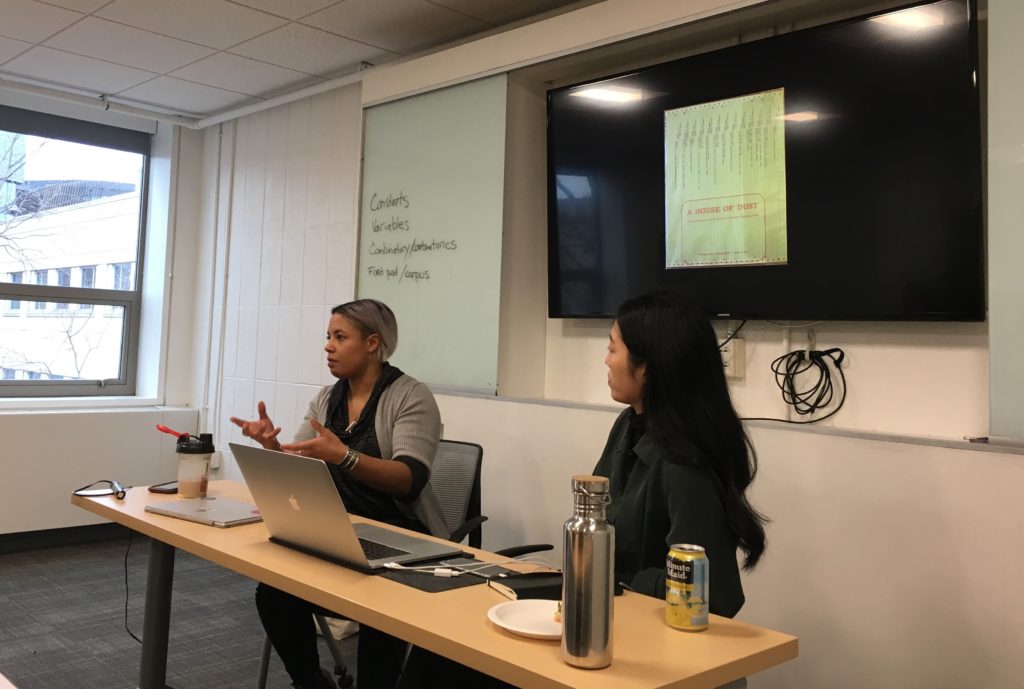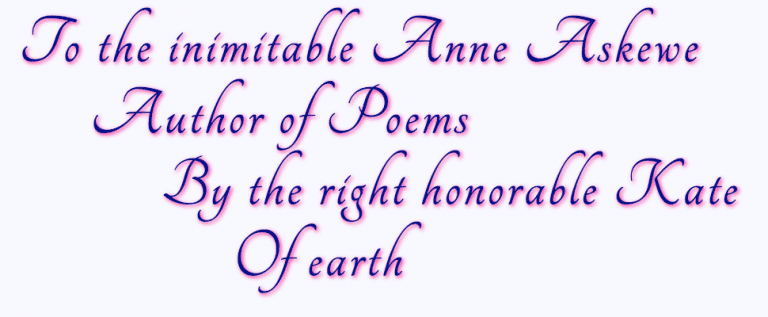By Sarah Payne
On February 23rd, the NULab hosted a workshop on computational poetry led by Mindy Seu, a graduate student in Harvard’s School of Design, and Lillian-Yvonne Bertram, an assistant professor of English at UMass Boston. They began the workshop by providing a brief overview of computational poetry, arguing that contemporary digital poetry has its roots in more material, analog examples which date as far back as the early modern period. Pre-digital examples included the Oulipo Movement, which originated in 1960s France, and Raymond Queneau’s Hundred Thousand Billion Poems. More recent examples of digital poetry include the Align Text Instagram page, which uses Google’s translation app, and All the Minutes, which pulls Tweets published at certain times of the day.

After the overview, Seu and Bertram discussed Nick Montfort’s adaptation of Alison Knowles’ “The House of Dust.” Seu and Bertram provided short coding tutorials and then allowed workshop participants to download “The House of Dust” files and make changes to the code, which they could then view in an online browser. Participants altered the content of the poem and also customized the appearance of their poems, changing the fonts, background colors, and spacing. Multiple participants changed the content and appearance of their poems to reflect recent debates on gun control and mental illness while others satirized the often-clichéd names of baking websites or generated humorous weather forecasts. After working individually on each of their poetry generators, participants then shared their results with the room while others asked questions or offered suggestions. Below, two of the workshop participants reflect on their experiences:
Sarah Payne (NULab Fellow): For my poetry generator, I chose to work with Bob Dylan’s song, “Subterranean Homesick Blues.” For those unfamiliar with the song, it can seem like a random jumble of words on a first listen. However, there are actually quite a number of allusions in the song. I also chose Dylan because of debates that arose when he won the Nobel Prize for literature in 2016 and whether his work was considered literary. Questions of randomness and literary merit, I felt, applied both to Dylan and computational poetry. I mixed Dylan’s lyrics with lines from “The House of Dust,” since Dylan’s song is also a mashup of other artist’s work such as Chuck Berry and Woody Guthrie. I kept the aesthetics relatively simple: black and white text that automatically generated new poems. This styling mimics the video for “Subterranean Homesick Blues.” The video is shot in black and white and features Dylan continually holding up and dropping cue cards with the song lyrics printed on them. Overall, I found that generating digital poetry was a defamiliarizing process that allowed me to gain some critical distance from textual poetry and therefore think differently about what we consider poetry in the first place.
Sarah Connell (NULab assistant director): In making my poetry generator, which I called “Dedication,” I wanted to use some of the techniques I’ve been learning lately and to work with data from Women Writers Online. So, I used XQuery to extract the 100 most common names of places in Women Writers Online, along with the 200 most common names of persons and the 100 most common textual titles named. Then, I used regular expressions to automatically reformat all of the different names to add the text I wanted around each one and set them up for the JavaScript template we were using. I decided to write my poem to follow a common way of titling dedicatory praise poems in our WWO texts—short poems included at the beginning of texts, written in praise of the author’s works. For example: “To the Incomparable Author, Mrs. Jane Barker, On her Excellent Romance of Scipina. By a Gentleman of St. John’s College, Cambridge” and “To the most Ingenious Astrea, upon her Book intituled, La Môntre, or the Lover’s Watch,” published with works written and translated by Jane Barker and Aphra Behn. What I like about this project is that it highlights the range of places, titles, and persons mentioned in WWO, while still showing some patterns in the kinds of names that come up: for example, biblical and classical names are very common among the names of persons, while places include both the real (London, Providence, Dublin) and the imaginary (Purgatory, heaven). The results are often humorously incongruous, which I really like:

I used the CSS to make my poem as ornate as possible, with some hot-pink shading on blue letters as a rather unsubtle gesture toward continuing conversations about gender norms and how those impact the ways that women participate in the public sphere today. All in all, this was a very enjoyable chance for me to think about the WWO collection in new ways and improve my CSS skills!



